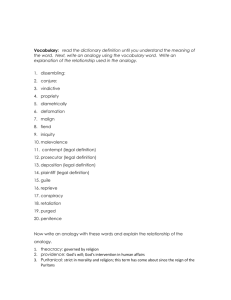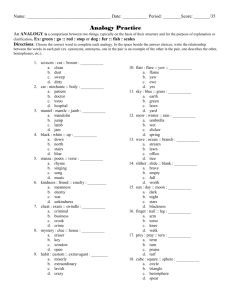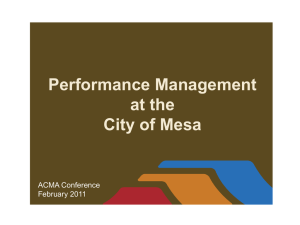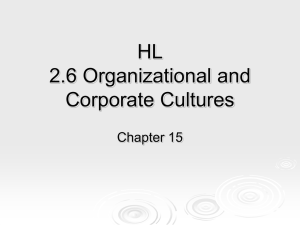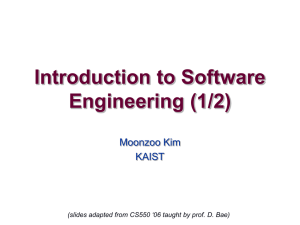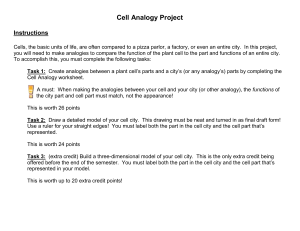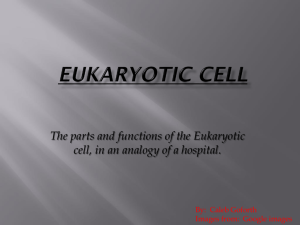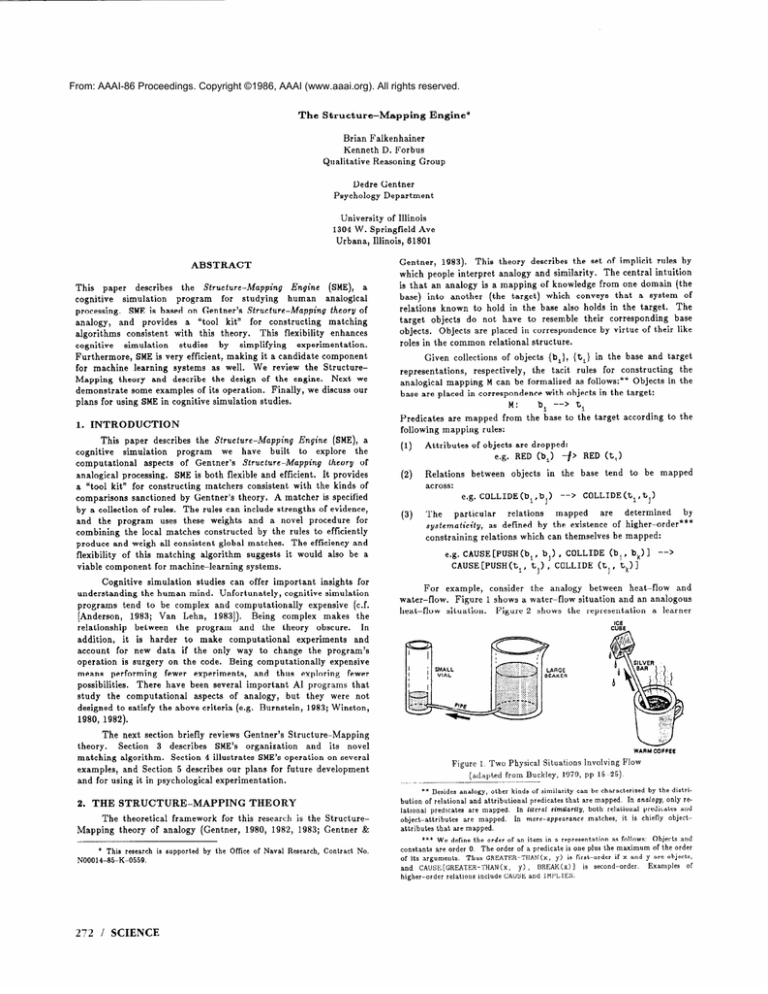
From: AAAI-86 Proceedings. Copyright ©1986, AAAI (www.aaai.org). All rights reserved.
The Structure-Mapping
Engine*
Brian Falkenhainer
Kenneth D. Forbus
Qualitative Reasoning Group
Dedre Gentner
Psychology Department
University of Illinois
1304 W. Springfield Ave
Urbana, Illinois, 61801
ABSTRACT
This
paper
describes
the Structure-Mapping
Engine
cognitive
simulation
program
for studying
human
SME is based on Gentner’s Structure-Mapping
processing.
(SME), a
analogical
theory of
and provides
a “tool kit” for constructing
matching
analogy,
algorithms
consistent
with this theory.
This flexibility
enhances
simulation
studies
by
simplifying
experimentation.
cognitive
Furthermore,
SUE is very efficient, making it a candidate component
for machine learning systems as well. We review the StructureMapping theory and describe the design of the engine.
Next we
demonstrate
some examples of its operation.
Finally, we discuss our
plans for using SME in cognitive simulation studies.
1. INTRODUCTION
This paper describes the Structure-Mapping
Engine
(HE), a
cognitive
simulation
program
we have
built
to explore
the
computational
aspects of Gentner’s
Structure-Mapping
theory of
analogical processing.
SME is both flexible and efficient.
It provides
a “tool kit,, for constructing
matchers consistent with the kinds of
comparisons sanctioned by Gentner’s theory. A matcher is specified
by a collection of rules. The rules can include strengths of evidence,
and the program
uses these weights and a novel procedure
for
combining the local matches constructed
by the rules to efficiently
produce and weigh all consistent global matches.
The efficiency and
flexibility
of this matching
algorithm
suggests it would also be a
viable component
for machine-learning
Gentner,
1983).
Th is theory describes the set of implicit rules by
which people interpret analogy and similarity.
The central intuition
is that an analogy is a mapping of knowledge from one domain (the
base) into another
(the target)
which conveys that a system of
relations known to hold in the base also holds in the target.
The
target
objects
do not have to resemble their corresponding
base
objects.
Objects are placed in correspondence
by virtue of their like
roles in the common relational structure.
Given
following
(1)
(2)
mapping
Attributes
of objects
e.g.
Relations
across:
between
The theoretical
framework
for this research is the StructureMapping theory of analogy (Gentner,
1980, 1982, 1983; Gentner &
(3)
272 / SCIENCE
is supported
by
the
Office
of Naval
Research,
Contract
No.
to the
objects
in the
RED (t,>
base
tend
to
COLLIDE (tl,
be
mapped
tl>
relations
mapped
are
determined
by
The
particular
systematicity,
as defined by the existence of higher-order***
constraining
relations which can themselves be mapped:
[PUSH(b,, bl>,
e.g.CAUSE
[PUSH
(ti
COLLIDE (bj, b,)] -->
tJ> , COLLIDE
,
(tl,
t,> 1
For example,
consider the analogy
between heat-flow
and
water-flow.
Figure 1 shows a water-flow situation and an analogous
heat-flow
situation.
Figure 2 shows the representation
a learner
ICE
CUBE
WARM COFFEE
Figure
I
Two
(adapted
_ _-~~
analogy,
Physical
from
other
kinds
Situations
Buckley,
Involving
Flow
1979,pp 15-25).
of similarity
can be characterized
by the distri-
bution of relational
and attributional
predicates
that are mapped.
In anelogy, only relational
predicates
are mapped.
In lateral simrlarity,
both relational
predicates
and
In mere-appearance
matches,
it is chiefly
objectobject-attributes
are mapped.
attributes
that are mapped.
*** We define
* This research
N00014-85-K-0559.
are dropped:
RED (b,)
-f>
e.g. COLLIDE (bl, bj > -->
** Besides
THEORY
rules for constructing
the
as follows:** Objects in the
rules:
CAUSE
The next section briefly reviews Gentner’s Structure-Mapping
theory.
Section
3 describes
SME’s organization
and its novel
matching algorithm.
Section 4 illustrates SME’s operation on several
examples, and Section 5 describes our plans for future development
and for using it in psychological experimentation.
{bi},{t,} in the base and target
of objects
base are placed in correspondence
with objects in the target:
t,
M:
b, -->
Predicates
are mapped from the base to the target according
systems.
Cognitive simulation
studies can offer important
insights for
understanding
the human mind. Unfortunately,
cognitive simulation
programs
tend to be complex and computationally
expensive (c.f.
[Anderson,
1983; Van Lehn, 19831).
Being complex
makes the
relationship
between
the program
and the theory
obscure.
In
addition,
it is harder to make computational
experiments
and
account for new data if the only way to change the program’s
operation is surgery on the code. Being computationally
expensive
means performing
fewer experiments,
and thus exploring
fewer
possibilities.
There have been several important
AI programs that
study the computational
aspects of analogy,
but they were not
designed to satisfy the above criteria (e.g. Burnstein,
1983; Winston,
1980, 1982).
2. THE STRUCTURE-MAPPING
collections
representations,
respectively,
the tacit
analogical mapping M can be formalized
the
order
of an item
in a representation
as follows:
Objects
and
constants
are order 0. The order of a predicate
is one plus the maximum
of the order
if x and y are objects,
of its arguments,
Thus GREATER-THAN(x,y) is first-order
Examples
of
and
CAUSE[GREATER-THAN(X,y), BREAK(x)] is second-order.
higher-order
relations
include CAUSE and IMPLIES.
Water Flow
The Structure-Mapping
theory has received a great deal of
convergent
theoretical
support
in artificial
intelligence
and
psychology.
Although
there are differences
in emphasis, there is
widespread agreement on the basic elements of one-to-one
mappings
of objects with carryover
of predicates (Burstein,
1983; Carbonell,
1983; Hofstadter,l984;
Kedar-Cabelli,
1985; Reed, 1985; Rumelhart
& Norman,
1981; Winston,
1982).
Moreover, all these researchers
have adopted something like the systematicity
principle, or a special
case of systematicity.
For example, Carbonell focuses on plans and
goals as the high-order
relations that give constraint
to a system,
and Winston
focuses on causality.
Also, some models combine a
structure-mapping
component,
which
generates
possible
interpretations
of a given analogy, with a pragmatic
component
which chooses the relevant
interpretation
(e.g., Burstein,
1983;
CAUSE
GREATER
FLOW(beaker,vial,water,pipe)
A
PRESSU&(beaker)
PRE&JRE(vial)
GREATER
B4
LIQUID(water)
FLAT-TOP(water)
CLEAR( beaker)
DIA-METER(beaker)
Heat
DIAMETER(via1)
Flow
Kedar-Cabelli,
GREATER
A
TEMPERi%JRE(coffee)
TEMPER&JRE(ice
cube)
FLOW(ice cube,coffee,heat,bar)
LIQUID(coffee)
FLAT-TOP(coffee)
Figure 2.
Simplified Water Flow and Heat Flow Descriptions
might have of these situations
In order
learner must:
(1)
(simplified
to comprehend
Set up th e object
heat-->
beaker
correspondences
“Heat
between
is like water”
a
Discard
object
attributes,
(3)
Map base relations
the two domains:
such as
to the corresponding
relations
beaker)
vial)
]
in the target
,
Observe
systematicity:
i.e., keep reIations
belonging
to a
systematic
relational
structure
in preference
to isolated
In this example,
relationships.
The base and target
representations
provided to SME are
collections
of facts called description
groups. Domain objects and
constants are collectively referred to as entities.
The construction
of
rules.
coffee),
1,
bar, coffee,
while isolated relations, such as
GREATER-THAN [DIAMETER (beaker)
are discarded.
, DIAMETER (vial)
and
the
believability
of each possible component of a match. Importantly,
to
build a new match function one simply loads a new set of match
is mapped into
TEMPERATURE (heat,
Ice
cube)
Ice
cube))
the candidate
the analogy is guided by match rules which specify which facts
entities
in the base and target
might match and estimate
CAUSECGREATER-THAN[PRESSURE(water,
beaker),
PRESSURE (water,
vial) 1 ,
FLOW(water, Pipe I beaker, Vial>>
FLOW(heat,
DESIGN
representation
of the target is used in SME to evaluate
inferences ~ that is the job of other modules.
domain.
CAUSECGREATER-THAN[TEMPERATURE(heat,
ENGINE:
predicates and objects in the base and target, plus a list of predicates
which exist in the base but not the target. This list of predicates is
the set of candidate inferences sanctioned by the analogy.
SME also
provides a syntactic evaluation of each mapping. In accordance with
no domain information
beyond
the
Structure-Mapping
theory,
such as CYLINDRICAL (beaker).
GREATER-THAN [PRESSURE (water,
PRESSURE (water,
a. THE STRUCTURE-MAPPING
psychological
is needed to
Given the descriptions
of a base and a target, SME constructs
all syntactically
consistent
analogical mappings between them.
As
noted above, the mappings
consist of pairwise matches
between
water,
tube --> metalbar,
--> coffee,
vial-->
Ice cube
(2)
(4)
Given the existing
theoretical
and empirical
support, we have decided that cognitive simulation
allow us to explore the theory still more deeply.
for clarity).
the analogy
1985).
Empirical
psychological
studies have borne out the prediction
that systematicity
is a key element of people’s implicit rules for
Adults focus on shared systematic
relational
analogical
mapping.
structure in interpreting
analogy.
They tend to include relations and
omit attributes
in their interpretations
of analogy, and they judge
analogies
as more sound and more apt if base and target share
systematic
relational
structure
(Gentner,
1980; Gentner & Landers,
1985; Gentner & Stuart, 1983). Finally, in developmental
work we
have found that children are better at performing difficult mappings
when the base structure is systematic (Gentner & Toupin, in press).
]
The systematicity
principle
is central
to analogy.
Analogy
conveys a system of connected knowledge, not a mere assortment
of
independent
facts.
Prefering
systems
of predicates
that contain
higher-order
relations
with
inferential
import
is a syntactic
expression of this tacit preference for coherence and deductive power
in analogy. It is the higher-order
relational structure that determines
which of two possible matches is made. For example, suppose
in the
previous example we were concerned with objects differing in specific
heat, such as a metal ball-bearing
and a marble of equal mass,
rather than temperatures.
Then DIAMETER becomes relevant, since
(in a more complete model than we have space for) DIAMETER affects
the capacity of a container, the analog to specific heat.
These rules are the key to SME’s flexibility.
An analogy is processed in three steps.
First,
all potential
pairings between items in the base and target are constructed
and
Second, all sets of consistent combinations
of
individually evaluated.
these pairings are constructed
to form the possible globa matches
and their corresponding
candidate inference sets. Finally, the global
matches
are evaluated
syntactically
to provide a score.
We now
describe these computations
in detail.
8.1.
Step
1: Construct
local
match
hypotheses
SME begins by finding for each entity and predicate in the base
the set of entities or predicates in the target that could plausibly
match that item.
Plausibility
is determined
by match hypothesis
constructor
rules, which take the form
(MHCrule
<condition>
<body>)
The body of these rules is run on each pair of items (one from the
base and one from the target) that satisfy the condition and installs
which represents
the possibility
of them
a ?netch hypothesis
COGNITIVE
MODELLING
AND
EDUCATION
/ 2’3
matching.
For example, we state
name is identical could potentially
that all predicates whose predicate
match with the rule
(MHCrule
(equal-functors?
(install-MH
*base-fact*
*base-fact*
*target-fact*)
*target-fact*))
8.2.
The likelyhood of each match hypothesis is found by running
match evidence
rules and combining their results. The evidence rules
provide support for a match hypothesis by examining the syntactic
properties of the items matched.
For example, the rule
(MHErule
(and
(equal
(mh-type
(equal-functors?
(MHevidence
*MH* 0.5
*MH*)
fact)
(mh-base-Item
(mh-target-Item
*MH*)
*MH*)))
0.0))
states “If the two items are facts and their functors are the same,
then supply 0.5 evidence in favor of the match hypothesis.“*
The
rules may also examine
match
hypotheses
associated
with the
arguments of these items to provide support based on systematicity.
This
causes
amount
evidence
of
for a match
higher-order
hypothesis
structure
to increase
supporting
it.
We
with
the
use
the
Dempster-Shafer
formalism
for probabilities
(Shafer,
1976) and
combine
evidence with a simplified
form of Dempster’s
rule of
combination
(Prade, 1983; Ginsberg, 1984). By using the simplified
formula we are assuming independence among the match hypotheses,
but this is not a problem because we are only using it to produce
scores for ordering candidates rather than estimating probabilities.
The state of the match between the water flow and heat flow
descriptions of Figure 2 after running these first two sets of rules is
shown in Figure 3. The weights shown in the figure are the support
for each match hypothesis.
Internally
the program stores a Shafer
interval, consisting of the support for the match and the maximum
plausible support (i.e., one minus the support against it). The water
flow - heat flow analogy is made possible by the program being able
to
match
predicates
Base
with
Match
Node
different
names,
Hypothesis
Target
such
Node
as
be discarded,
DIAMETER
matching
Step
such
as LIQUID(water)
H
(vial)
TEMPERATURE
2: Global
Match
GREATERTWUpcrh”rc
GREATERDiamcter
GREATERT.mprr.ture
PRESSUREbc,ker
TEMPERATUREcalIle
PRESSUREYi,,
TEMPERATURE,*
D1*ETERbd~r
TEMPERATUREcome
DIAMETER,.,
TEMPERATURE,ee
*Low”.te*
*Lowhrrl
The
key to forming
0.712
c~br
0.712
0.790
0.790
ice
0.932
cube
beaker
coffee
0.932
water
water
coffee
heat
0.804
pipe
bar
0.632
Gmap
#l:
0.632
Figure 3.
After
Rules
++ TEMPERATURE,,)
(PRESSURE,,
++ TEMPERATURE,,)
( (beaker
Weight:
0.9800
Gmap
and TEMPERATURE.
This behavior
is caused by the
particular
set of rules we are using.
In these rules, relational
predicates
such as GREATER are limited to matching
predicates
while functional
predicates
such as
having
the same name,
#2:
PRESSURE
++ coffee)
TEMPERATURE can match other functional predicates.
Note that at
this stage, SME is entertaining
a number of matches that will later
* Evidence is attributed to a match hypothesis in the form of two numbers.
number
corresponds
to evidence
in favor
of the match
and
the second
number
The
in-
274
to one.
/ SCIENCE
)
cube)
bar)
)
GREATER,,
H
++ TEMPERATWRETP)
Emaps:
{ (water
Weight:
0.0004
FLOW)
)
TEMPERATURE*,)
++ coffee)
Inferences:
( (LIQUID
+-+ FLOW)
++ GREATER,,)
(
(vial
CI coffee)
Inferences:
{
t-)
ice
(FLAT-TOP
j
)
(b)
Figure
4.
1
cube)
)
)
t--* LIQUID)
dicates evidence against the match. The sum of these number8 must be less than or
equal
e,
ice
(DIAMETER,,
0 0195
Candidate
(pipe
c-t
(DIAMETERn,
Weight:
#3:
(vial
[ (CAUSE
Inferences:
{ (beaker
Gmap
++ heat)
( (GREATER,,
Emaps.
Candidate
(FLOW
(PRESSURE,,
Emaps
Candidate
Running Local
++ GREATER,,)
( (GREATER,,
(water
first
the sets of
0.790
vial
Match
is constructing
0.712
*LATcoffrc
Flow
the mappings
entity correspondences
(called Emaps).
Mappings are constructed
in
four steps. First, find all entity justifiers.
An entity justifier is a
match hypothesis that directly justifies one or more Emaps, in that
Second, associate
with each
some of its arguments
are entities.
match hypothesis
the set of Emaps that it implies.
This step is
accomplished
by propagating
Emaps upwards from entity justifiers.
The set of Emaps that a match hypothesis supports is simply the
union of all Emaps supported by its descendents.
Third, create a
collection of globally consistent matches, called Gmaps. Call a match
hypothesis that is not the descendent of any other match hypothesis
a root. Notice that if the Emaps supported by a root are consistent,
then the entire structure under it is consistent.
In the simplest case,
the entire collection of descendents may be collected together to form
a globally consistent match.
However, if the root is not consistent,
then the same procedure is applied recursively to each descendent.
The result is a collection of sets of match hypotheses, within which
all Emaps are consistent.
The final step is to generate all consistent
combinations
of these sets, keeping those combinations
that are
maximal.
This is done by first combining Gmaps which are part of
0 712
rubs
LIQulDcollrc
Heat
Construction
Once the individual match hypotheses have been constructed
and analyzed, SME builds a set of analogical mappings between the
base and target.
Each mapping is a maximal set of consistent match
hypotheses
plus the candidate
inferences
supported
by those
Consistency
is enforced
by insisting
that a match
hypotheses.
hypothesis MH is in the analogy only if the mapping includes other
match hypotheses
that pair up all the arguments
of the base and
target
items of MH. The mappings are maximal
in that adding
another match hypothesis would lead to a contradiction,
as indicated
by a base item being matched to two target items or vice versa.
0.650
LIQU?dW
-
and
0.650
FLAT*.,e*
Flow
++ LIQUID (cof fee)
cube).
Evidence
GREATERPltllllre
Water
(ice
Gmap
Construction
++ FLAT-TOP)
1
the same base structure
(e.g. the Gmap for the pressure inequality
would combine with the Gmap for the flow relation to form a single
any further
combinations
which are
Gmap)
and then making
consistent.
Figure 4(a) shows how the initial set of Gmaps is formed,
while Figure 4(b) shows the final Gmaps created for the water flow heat flow analogy.
4.1. Solar System - Rutherford Atom Analogy
The Rutherford
model of the hydrogen atom was based on the
well-understood
behavior
of
the
solar
system.
Given
the
descriptions
shown in Figure 5, the Structure-Mapping
engine
constructed
three
possible
interpretations.
The most, preferred
Associated
with each Gmap is a (possibly
empty)
set of
candidate inferences. Candidate
inferences are base predicates that
would fill in structure
which is not in the Gmap (and hence not
already in the target).
In Figure 4(b), for example, Gmap #l has the
as its sole candidate
inference.
If the
top level CAUSE predicate
FLOW predicate
was not present in the target, then the candidate
inferences
for a Gmap corresponding
to the pressure inequality
would be both CAUSE and FLOW. All candidate inferences must be
In addition,
they must be
consistent
with known target
facts.
Solar
System
CAUSE
AND
Revolve-Around(planet,sun)
ATTRnCe;TER
consistent
with the Gmap’s
structure
and supported
by some
member of it. For example, GREATER-THAN
[DIAMETER
(cof
f ee) ,
is not a valid candidate inference for the
DIAMETER(1ce
cube)]
first Gmap because it does not intersect the existing Gmap structure.
GREATER
J32
MASS(sun)
B3
MASS(planet)
YELLOW(sun)
A
8.3.
Step
8: Global Match
Selection
1’EMPERJ%JRE(sun)
Several factors must be taken into account
which Gmap is the best analogy .. We have identified
particularly
important:
(1)
The evidence
Gmap.
(2)
The candidate
(3)
The graph-theoretic
structure
of the Gmap,
and relative size of connected components.
for
when
deciding
three factors
the
individual
match
hypotheses
inferences
sanctioned
by the Gmap.
TEMPER?TURE(planet)
as
Rutherford
in the
m.
-3
MASS(~~cleus)
e.g., the number
Exploring the relative importance of these and other factors is
part of the desiderata
for SME, hence we have made the criteria
Gmap
evidence
rules, whose form is much the same
programmable.
as the other kinds of rules mentioned
previously,
can provide
evidence
for a Gmap
based on whatever
factors
are deemed
appropriate.
To make an appropriate selection, evidence for Gmaps
is combined under strict adherence to Dempster’s rule for combining
probabilities.
Thus the set of Gmaps is treated as a set of mutually
exclusive choices, and evidence in favor of one Gmap implicitly
counts as evidence against the others. Dempster’s rule automatically
normalizes the weights so that the sum of the weights supporting
each Gmap will always be less than or equal to one. In Figure 4(b),
the Gmap which maps the PRESSURE
relation is believed more than
the Gmap which maps the DIAMETER
relation.
This conclusion is
based on two rules. The first rule simply permits the evidence for a
match hypothesis in a Gmap to count as evidence for that Gmap.
The second rule gives evidence of 0.3 to a Gmap for each candidate
inference it sanctions.
We suspect tnat the ability to “tune” the criteria for choosing
a Gmap will be important
for modeling individual differences in
analogical style and a subject’s domain knowledge.
For example, a
taking
Gmaps
with
some
conservative
strategy
might
favor
candidate
inferences but not too many, in order to maximize the
probability
of being right.
4. EXAMPLES
The Structure-Mapping
engine has been tested on a number of
examples
drawn from a variety
of domains.
We discuss a few
examples
to further
demonstrate
SME’s
flexibility
and generality.
Our first example is taken from Rutherford’s
analogy between the
and the hydrogen
atom.
The second
example
solar
system
demonstrates
how
the
program
reasons
about
complicated
descriptions of water flow and heat, flow which were generated by a
qualitative reasoning program before the inception of SME.
Atom
GREATER
MASS(electron)
ATTRACT(nucleus,electron)
REVOLVE-AROUND(electron,nucleus)
Figure
5
Solar
System
-
Rutherford
Atom
Analogy
mapping (given a weight of 0.99) pairs up the nucleus with the sun
and the planet with the electron.
This mapping is based on the mass
inequality
in the solar system playing the same role as the mass
inequality in the atom. It sanctions the inference that the inequality,
together with the mutual attraction
of the nucleusand the electron,
causes the electron to revolve around the nucleus. The other major
Gmap (given a weight of 0.01) has the same entity correspondences,
but is based on the solar system’s temperature
inequality mapping to
the atom’s
mass inequality.
There
is much less belief in this
interpretation
because the temperature
and mass predicates
are
different
and because this Gmap does not allow any candidate
inferences.
The third Gmap is a spurious collection
of match
hypotheses which imply that the mass of the sun and planet should
correspond
to the mass of the electron and nucleus, respectively.
There is no higher-level
structure to support this interpretation
and
so the final belief is 1x10-s.
This example demonstrates
how SME is
able to generate
all syntactically
plausible
interpretations
of a
potentially
analogous situation.
It also show that, our rules have a
preference for matching predicates of the same name (e.g. MASS with
MASS),
but is able to match predicates with different names (e.g.
TEMPERATURE
with MASS).
4.2. Water Flow - Heat Flow Analogy
The
Structure-Mapping
engine
has
applications
beyond
cognitive
simulation.
For example, we could use this program in
conjunction
with a qualitative reasoning program to model the way
people use analogy to reason about the physical world. Figure 6 (a)
shows a domain description
for water flow which was used in an
actual
qualitative
reasoning
program
(Forbus
1984; Forbus
&
Gentner, 1983). Figure 6 (b) s h ows a greatly reduced version of the
same program’s description of heat, flow.
As with the earlier,
simplified descriptions of water flow and
heat
flow,
SME
was
able
to
make
the
correct
analogical
correspondences,
creating all of the possible candidate inferences in
COGNITIVE
MODELLING
AND EDUCATION
/ 275
6. CONCLUSIONS
SME has significant advantages over more traditional matching
algorithms.
Methodologically,
the advantage
of producing
all
possible mappings is that one can easily see syntactically
consistent
alternatives
to the best match.
Yet SME’s matching
algorithm
is
very
efficient,
avoiding
the
extensive
backtracking
normally
associated with pattern-matching
systems.* On our large water flow
- heat flow example, the program took only 0.7 seconds to perform
the entire match on a Symbolics
3640.
This includes everything
from the construction
of local match hypotheses to the gathering of
candidate inferences and Gmap construction.
The smaller examples
average 0.4 seconds.
The current program needs to be expanded to
properly handle predicates which are commutative
(e.g. SUM) or take
a variable number of arguments
(e.g. AND), In addition, we would
like to add the ability to introduce new entities when required by the
analogical mapping through the use of Skolem functions.
The results
of SME’s operation
on the examples
above provides
suggestive evidence concerning a currently debated issue in analogy.
Th e question concerns
how much a purely syntactic
account of
analogy can do. Although many researchers have adopted variants
of the systematicity
principle, often specific domain knowledge or
pragmatic
information
is used as well. For example,
Carbonell
(1981, 1983) focuses on plans and goals as the relevant higher-order
relations
for analogical
mapping.
Winston’s
(1982) system uses
causal
relations
in its importance-guided
matching
algorithm.
Winston
[personal
communication,
November
19851 has also
investigated
goal-driven
importance
algorithms.
The extreme view
is taken by Holyoak (1985), whose account of analogical mapping
relies solely on the relevance
of predicates
to the current
plan.
Among the claims of these researchers
are (1) purely syntactic
information
is insufficient to guide analogical mapping and (2) even
if it were sufficient,
such a system would be inefficient
(e.g.
Burnstein,
otherwise,
LCBcube
Figure
6.
Water
Flow
(a) and Heat
Flow
(b)
the process.
Interestingly,
only one consistent
interpretation
arose.
All other match hypotheses
were eliminated
because they had no
descendants
to support their existence.
The candidate
inferences
made were the correct ones, namely that a difference in temperature
and an aligned heat path implies an instance of heat flow and that
the rate of heat flow between two objects is proportional
to the
difference in their temperatures.
1986, p.358).
The evidence from SME so far suggests
since it generates intuitively plausible answers and does so
rapidly.
We intend to explore this issue more fully by using a
variety of examples to see if and when the purely syntactic approach
breaks down. Clearly content knowledge must be invoked at some
point to evaluate whether the candidate
inferences
from a given
This suggests
a model which uses a
analogy
are appropriate.
context-sensitive,
expectation-driven
system to evaluate the output
of SME. This extension is compatible with the combination
models
proposed by Burstein (1983) and Kedar-Cabelli
(1985).
In addition to tests of the basic algorithm,
we plan several
cognitive
simulation
studies of analogical
reasoning
and learning.
We mention only one here. P syc h o 1ogical research shows a marked
developmental
shift in analogical processing.
Young children rely on
surface information
in analogical mapping; at older ages, systematic
mappings are preferred (Gentner & Stuart, 1983; Gentner & Toupin,
in press; Holyoak, Juin & Billman, 1985; Vosniadou, 1985). Further,
there is some evidence that a similar shift from surface to systematic
transition
in adults (Chi,
mappings
occurs in the novice-expert
Glaser & Reese 1982; Larkin, 1985; Novick, 1985; Reed, 1985; and
Ross, 1984).
4.8.
Summary
Space limitations
forbid a detailed account of our experiments
to date; we summarize
two here.
First, we have analyzed short
stories described in predicate calculus to compare mere appearance,
surface matches with true analogy.
Second, we have begun exploring
a number of match algorithms.
For example, one set of rules focuses
on object
attributes
(mere-appearance
matches),
thus mimicking
how children
tend to treat potentially
analogous situations
(see
below).
These rules, when run on the water flow - heat flow
descriptions of Figure 2, choose the water to coffee correspondence
as
the best interpretation
due to their surface similarity
and fail to
notice the relational
structure which implies that the role of water
actually corresponds
to the role of heat in the water flow and heat
flow situations.
270
/ SCIENCE
In both
cases there
are two very different
interpretations
for
this analogical shift: (1) acquisition of knowledge; or (2) a change in
the analogy algorithm.
The knowledge-based
interpretation
is that
children
and novices lack the necessary
higher-order
relational
The second explanation
is that
structures to guide their analogizing.
for analogical
mapping
changes,
either
due to
the algorithm
maturation
or learning.
In h uman learning it is difficult to decide
and practice
in
this issue, since exposure to domain knowledge
analogy and reasoning tend to occur simultaneously.
SME gives us a
unique opportunity
to vary independently
the analogy algorithm and
the amount and kind of domain knowledge.
For example, we can
compare identical evaluation algorithms operating on novice versus
* While we have
this matching
algorithm
not yet explored
this possibility,
It appears
that
could be very useful for connectionist
architectures
a variant
of
representations,
or we can compare
different
analogy
expert
evaluation rules operating on the same representation
(see summary
above).
The performance
of SME under these conditions
compared with novice versus expert human performance.
can be
Skorstad
for invaluable
REFERENCES
Anderson,
J., The
Press, Cambridge,
Buckley,
York,
S., Sun
1979
Architecture
Mass, 1983.
up
to sun
of
Cognition,
Harvard
dozen, McGraw-Hill
University
Company,
New
Burstein,
M. H., Concept
formation
by incremental
analogical
Machine
Learning:
An Artificial
reasoning
and debugging.
Intelligence
Approach
Vol. 11, R.S.Michalski,
J.G.Carbonell,
and
T.M.Mitchell
(editors), Morgan Kaufmann,
1986.
Carbonell,
J. G. Learning by analogy: Formulating
and generalizing
plans from past experience.
Machine Learning, Michalski, R. S.,
(Eds.),
Tioga
Publishing
Carbonell,
J.,
and Mitchell,
T.
Company, Palo Alto, California, 1983.
analogy
in problem
solving and
Carbonell,
J. G., Derivational
knowledge
acquisition.
Proceedings
of the Second International
Machine
Learning
Workshop,
University
of Illnois, Monticello,
Illinois, June, 1983.
Chi, M. T. H., Glaser,
R., & Reese, E.
In R. Sternberg
(Ed.), Ad vances
intelligence
(Vol.1). Hillsdale, N.J.,
Forbus,K.D.,
Laboratory
Expertise in problem solving.
in the psychology
of human
Erlbaum, 1982.
Qualitative
Process Theory. MIT Artificial
Technical Report No. 789, July, 1984.
Intelligence
Forbus,K.D.,
and D.Gentner,
Learning Physical Domains: Towards a
Machine
Learning:
An
Artificial
Theoretical
Framework.
Intelligence
Approach
Vol. 11, R.S.Michalski,
J.G.Carbonell,
and
T.M.Mitchell
(editors), Morgan Kaufmann,
1986.
Gentner,
D., The structure
Tech.
Report
No. 4451,
Newman Inc., 1980
Gentner,
D., Are scientific
Metaphor:
Problems
and
Brighton, England, 1982
of analogical
Cambridge,
models in science. BBN
MA., Bolt Beranek
and
analogies
metaphors?.
perspectives,
Harvester
Gentner,
D., Structure-mapping:
A
analogy. Cognitive
Science 7(2), 1983
theoretical
In Miall, D.,
Press,
Ltd.,
framework
Academic
Kedar-Cabelli,
ACKNOWLEDGEMENTS
The authors wish to thank Janice
assistance in encoding domain models.
New York:
Press,
1984.
Holyoak, K. J., Juin, E. N. & Billman, D. 0. (in press). Development
of analogical problem-solving
skill. Child Development.
S. (1985).
the Seventh
Irvine, CA.
Annual
Purpose-directed
of the
Conference
analogy. Proceedings
of
Cognitive Science Society,
Larkin, J. H. Problem representations
in physics. In D. Gentner &
A. L. Stevens (Eds.) Mental Models.
Hillsdale, N. J., Lawrence
Erlbaum Associates, 1983.
Novick,
L.
conceptual
1985.
R. Transfer
and expertise
analysis. Stanford University:
Prade,H., A Synthetic View of Approximate
Proceedings
of the 8th International
Joint
1983.
Intelligence,
Reed, S. K.
presented
1985.
in problem
Unpublished
Reasoning
Conference
solving:
A
manuscript,
Techniques.
on Artificial
A structure-mapping
model for word problems.
Paper
at the meeting of the Psychonomic
Society, Boston,
Ross, B. H. Remindings
Cognitive
Psychology,
and their effects in learning
16, 371-416, 1984.
a cognitive
skill.
Rumelhart,
D. E., & Norman,
D. A.
Analogical
processes
in
Cognitive
skills and their
learning.
In J. R. Anderson
(Ed.),
acquisidion, Hillsdale, N.J. Erlbaum, 1981.
Shafer,G.,
A Mathematical
Theory of Evidence,
Press, Princeton,
New Jersey, 1976.
Princeton
University
Van Lehn, K. & Brown, J. S. Planning nets: A representation
for
formalizing analogies and semantic models of procedural skills. In
R. E. Snow, P. A. Federico & W. E. Montague (Eds.), Aptitude,
learning and instruction:
Cognitive process
analyses.
Hillsdale, N.
J. Erlbaum, 1980.
Van Lehn, K., Felicity
Conditions
for Human Skill Acquisition:
Validating
an AI-based
Theory. Xerox Palo Alto Research Center
Technical Report CIS-21, 1983.
Vosniadou,
University
S.
On the development
of metaphoric
competence.
of Illinois: Manuscript submitted for publication, 1985.
Winston,
P.
Communications
H.
Learning
of the ACM,
and
reasoning
23(12), 1980.
Winston,
P. H. Learning
new
exercises.
Artificial
Intelligence,
by
analogy.
principles
from precedents
19, 321-350,
1982.
and
for
Gentner D., & Gentner, D. R., Flowing waters or teeming crowds:
Mental models of electricity,
In D. Gentner
& A. L. Stevens,
(Eds.), Mental Models, E r lb aum Associates, Hillsdale, N.J., 1983
Gentner, D., & Landers, R. Analogical reminding:
of the International
hard to find. In Proceedings
Systems, Man and Cybernetics.
Tucson, Arizona,
A good match is
Conference
on
1985.
Gentner,
D., & Stuart, P. Metaphor
as structure-mapping:
What
develops. Bolt Beranek and Newman Technical Report No. 5479,
Cambridge, Massachusetts,
1983.
Gentner,
D. & Toupin,
C. (in press). Systematicity
and surface
similarity in the development of analogy. Cognitive Science.
Ginsberg,M.L.,
Proceedings
Non-Monotonic
Reasoning
AAAI, August, 1984.
Using
Dempster’s
Rule.
The
Copycat
project:
An experiment
in
Hofstadter,
D. R.
nondeterministic
and creative analogies. M.I.T. A.I. Laboratory
memo 755. Cambridge, Mass: M.I.T., 1984.
Holyoak,
K. J.
H.Bower (Ed.)
The pragmatics
of analogical
transfer.
The psychology
of learning
and motivation.
In G.
Vol.1.
~~GNITI~EM~DELLINGANDEDUCATION
1
277

